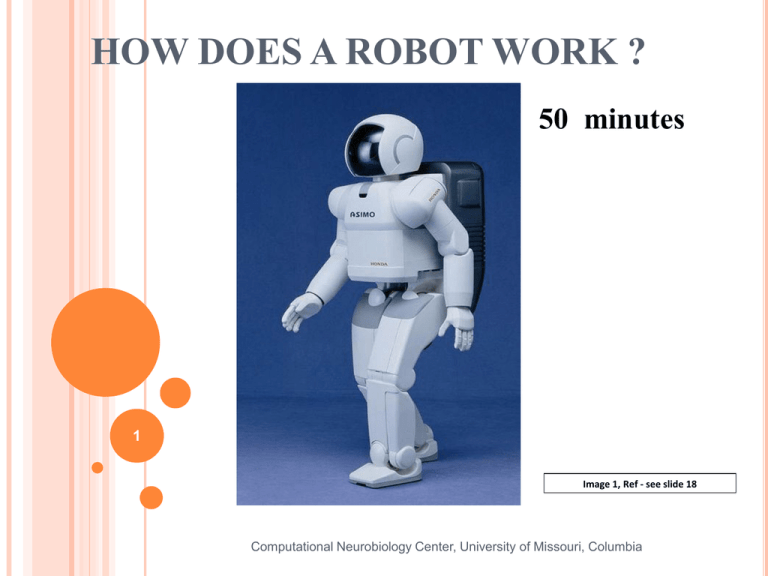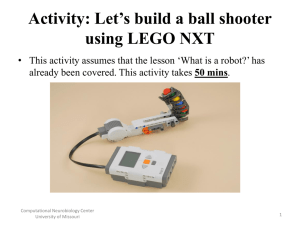
HOW DOES A ROBOT WORK ?
50 minutes
1
Image 1, Ref - see slide 18
Computational Neurobiology Center, University of Missouri, Columbia
PRE ASSESSMENT QUESTIONS
1.
What is electricity?
2.
Name two electric devices we use daily and how they work.
3.
Mention two devices that do not use electricity.
4.
Name one common form of storing electrical energy.
2
Computational Neurobiology Center, University of Missouri, Columbia
ELECTRICITY
Have you ever wondered what makes a cell phone,
refrigerator or a light bulb work?
One thing that all these devices have in common is ‘they are
all electronic devices’ which means they work when charged
with electricity.
So what is ‘Electricity’?
The words ‘electron’ , ‘electric’, ‘electricity’ originate from
the Greek word ‘elektor’, meaning ‘beaming sun’.
Electricity is flow of electrical charge. Everything in the
universe is made of atoms and atoms are made of even smaller
particles called ‘electrons’, ’protons’ and ‘neutrons’ , some of
which are charged. Electricity is due to the flow of electrons
that have gotten loose from atoms.
Computational Neurobiology Center, University of Missouri, Columbia
3
ELECTRIC CURRENT
Electricity is the flow of electrical charges through
conductors.
Image 2, Ref - see slide 18
4
Computational Neurobiology Center, University of Missouri, Columbia
ELECTRIC CURRENT
Example
for direct current: electricity
created by batteries.
Electricity comes from outlets at home too
– but don’t use them!.
Electric current passes through metals.
Example: Copper wire is a very good
conductor of electricity, wood is a poor
conductor of electricity.
Batteries
Electrical outlet
Wood
5
Copper Wire
Computational Neurobiology Center, University of Missouri, Columbia
WHAT IS A BATTERY?
•
•
•
A battery is a source of electrical current. It is a device
that stores chemical energy which is converted to
electrical energy when connected in a circuit. That is, it
caused electrons (charged particles) to flow through
conductors.
Batteries are of two types:
- Primary: these cannot be recharged.
- Secondary: these batteries can be recharged.
When a metal wire is connected across the two terminals
of a battery (one positive and one negative), an electric
current passes through the conductor (metal wire).
Computational Neurobiology Center, University of Missouri, Columbia
6
ELECTRICAL CIRCUIT
•
•
•
•
What is an electric circuit?
A source of electricity (battery) connected to one
terminal of any electrical device (e.g., motor) using a wire,
with the other terminal of the device connected back to the
source through another wire is a simple ‘electric circuit’.
Electric circuits are of two types:
- Open – the wire not connected back to the source.
- Closed – the wire connected back to the source.
For electricity to flow, an electric circuit should be closed.
Watch this video:
http://www.youtube.com/watch?v=AY9qcDCFeVI
Computational Neurobiology Center, University of Missouri, Columbia
7
CLOSED AND OPEN CIRCUITS
CLOSED CIRCUIT
OPEN CIRCUIT
8
Computational Neurobiology Center, University of Missouri, Columbia
HOW DOES A BATTERY PRODUCE ELECTRICITY?
•
•
•
In the figure, you see a circuit:
- Battery’s (source) positive
terminal connected to
switch and negative
terminal connected to
motor (electrical device).
When the switch is pressed, the
circuit is closed and electricity
Image 3, Ref - see slide 18
flows to power the motor.
Motor: Converts the electrical energy to useful
mechanical energy (movement of motor)
Computational Neurobiology Center, University of Missouri, Columbia
9
DEMONSTRATION OF AN ELECTRIC CIRCUIT
•
•
This demonstration takes 10
minutes assuming
the electric circuit is
already assembled.
Components needed:
–
–
–
–
–
Bread board
DC motor
Battery
LED
Buzzer
Buzzer
LED
Bread Board
DC motor
10
Computational Neurobiology Center, University of Missouri, Columbia
SIMPLE ELECTRIC CIRCUIT
Connect the black wire of the battery to the rails. What happens?
Red wire: positive (+) terminal
Black wire: negative (-) terminal
Battery
Motor
LED
Buzzer
Slide provided by Dr. Jae Kwon,
Univ of Missouri
11
Computational Neurobiology Center, University of Missouri, Columbia
BATTERY IN THE
•
•
•
LEGO ROBOT
In the figure, you see the
battery used in LEGO NXT robot.
This is a ‘secondary’ type
battery as it can be recharged.
When this battery is inserted
into the battery case of NXT, it
LEGO NXT battery
powers the NXT robot and when
you press the orange button on the brick it is similar to pressing
the switch to ‘close’ the circuit.
12
Computational Neurobiology Center, University of Missouri, Columbia
LED, BUZZER AND MOTOR NEED
ELECTRICITY TO WORK
Electricity comes from energy stored in the battery.
The electrical circuit enables the LED to convert electrical energy
to light energy.
Similarly, the circuit enables the buzzer convert electrical energy
to sound energy.
Finally, the motor converts electrical energy into mechanical
energy, similar to what is done in your NXT taskbot.
13
Computational Neurobiology Center, University of Missouri, Columbia
THE LEGO NXT MOTOR OPENED UP
•
When the circuit is
closed , the battery
powers the motor and
drives the gear train
inside the motor which
in turn drive the wheels
of the robot.
Can you see that the NXT
motor inside is similar to
the demo motor!
14
Image 4, Ref - see slide 18
Computational Neurobiology Center, University of Missouri, Columbia
ACTIVITY:
BALL SHOOTER - USING LEGO NXT
Switch to the Activity PowerPoint
15
Image 5, Ref - see slide 18
Computational Neurobiology Center, University of Missouri, Columbia
POST-ASSESSMENT QUESTIONS
1.
Draw a simple electric circuit to show how a bulb can be lighted using a
switch.
2.
How does an NXT motor move?
3.
Electrical energy can be converted to other forms of energies. Name two
forms and electrical devices that use them.
4.
Mention any human activity analogous to NXT motor shooting balls.
16
Computational Neurobiology Center, University of Missouri, Columbia
POST-ASSESSMENT QUESTIONS
1.
Draw a simple electric circuit to show how a bulb can be lighted using a
switch.
See picture on slide 8
2. How does an NXT motor move?
The NXT battery supplies electrical energy to the motor and makes it move
3.
Electrical energy can be converted to other forms of energies. Name two
forms and electrical devices that use them.
Buzzer – converts electrical energy to sound energy.
LED – converts electrical energy to light energy.
4.
Mention any human activity analogous to NXT motor shooting balls.
Using of your arm to throw a ball.
Computational Neurobiology Center, University of Missouri, Columbia
17
IMAGE SOURCE/RIGHTS
Image 1:ADA Description: Robot
Image file name: robot.jpg
Source/Rights: commons.wikimedia.org
Image 2:ADA Description: Electricity
Image file name: electricity flow
Source/Rights: Copyright © 2004 Microsoft Corporation, One Microsoft Way, Redmond, WA 98052-6399 USA.
All rights reserved
Image 3:ADA Description: Simple Electric Circuit
Image file name: battery.jif
Source/Rights: static.howstuffworks.com/gif/battery.gif
Image 4:ADA Description: NXT Motor internal parts
Source/Rights: Photo Courtesy Daniele Benedettelli
Image 5:ADA Description: NXT Ball shooter
Image file name: ball_shooter.htm
Source/Rights:http://www.nxtprograms.com/NXT2/ball_shooter/index.html
18
Computational Neurobiology Center, University of Missouri, Columbia
END OF LESSON
19
Computational Neurobiology Center, University of Missouri, Columbia










